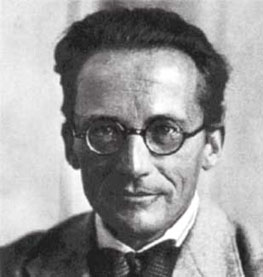| Erwin Schrödinger  AKA Erwin Rudolf Josef Alexander Schrödinger AKA Erwin Rudolf Josef Alexander Schrödinger
Born: 12-Aug-1887
Birthplace: Vienna, Austria
Died: 4-Jan-1961
Location of death: Vienna, Austria
Cause of death: Tuberculosis
Remains: Buried, Alpbacher Friedhof, Tirol, Austria
Gender: Male
Religion: Roman Catholic
Race or Ethnicity: White
Sexual orientation: Straight
Occupation: Physicist Nationality: Austria
Executive summary: Schrödinger's wave equation Military service: German Army (WWI, Italian Front) Austrian physicist Erwin Schrödinger won the Nobel Prize for Physics in 1933, for his 1926 introduction of Schrödinger's wave, the mathematical equation of wave mechanics that is still the most widely used piece of mathematics in modern quantum theory. It posits a non-relativistic wave equation that governs how electrons behave within the hydrogen atom. He worked on analytical mechanics, applications of partial differential equations to dynamics, atomic spectroscopy, color theory, cosmology, counter (or detector) statistics, eigenvalue problems, electromagnetic theory, general relativity, James Clerk Maxwell's equations, meson physics, optics, radiation theory, solid-state physics, statistical mechanics, thermodynamics, and the unified field theory. He also wrote extensively on the history of science, and existential questions of life.
He introduced his famous "Schrödinger's cat" paradox in a 1935 paper, "The present situation in quantum mechanics". The cat quandary was intended to illustrate the absurdity of quantum physics, which must deal in probabilities rather than observable certainties. The scenario varies, but generally "Schrödinger's cat" tells the story of a cat sharing a closed box with an elaborate booby trap consisting of a vial of cyanide gas, a small but deadly quantity of radioactive material, and a radiation detector. If the radiation detector senses decay in the radioactive material at the atomic level it triggers the release of the poison gas and the cat is killed; but if radioactive decay is not detected then the cat enjoys a quiet nap and no harm is done. So long as the box remains closed scientists cannot observe whether the cat is dead, but until the box is opened and the cat is observed, the cat exists in an indeterminate state and must be assumed to be both dead and alive. Beyond this odd conundrum lies an odder paradox of quantum physics, that quantum level observations of position with regard to momentum are indeed as indeterminate as the cat's state of life or death.
Though Catholic by faith Schrödinger was infuriated by Germany's anti-Jewish laws. In 1933, when an English scientist visited the University of Berlin to try to arrange safe exit from Germany for several of the school's Jewish scientists, Schrödinger — one of the world's most famous scientists — startled the visitor by asking if he could arrange passage for himself and his family. After leaving Germany he spent a few years at Cambridge, then relocated to Austria's University of Graz — which became Adolf Hitler University after the Nazis invaded Austria, leading Schrödinger to flee another nation. He eventually took residence at the Dublin Institute for Advanced Studies, where he worked for seventeen years, by far his longest stint at any one institution.
Schrödinger had a long, happy, and very open marriage with Annemarie Bertel, daughter of a respected chemist. He kept a detailed log of his numerous sexual escapades, included a teen-aged girl he seduced and impregnated while acting as her math tutor. He had children by at least three of his mistresses, including a daughter by Hilde March, the wife of his colleague Arthur March, who was himself a lover of Schrödinger's wife. Father: Rudolf Schrödinger (linoleum factory manager)
Mother: Georgine Emilia Brenda Bauer ("Emily")
Wife: Annemarie Bertel (m. 24-Mar-1920, no children)
Mistress: Hilde March (wife of Arthur March, one daughter)
Daughter: Ruth Georgie Erica (b. 30-May-1934, with Hilde)
High School: Akademisches Gymnasium, Vienna, Austria (1906)
University: BS Physics, University of Vienna (1910)
University: PhD Experimental Physics, University of Vienna (1914)
Teacher: Meterorology, University of Vienna (1917-18)
Teacher: Physics, University of Vienna (1918-20)
Teacher: Physics, University of Jena (1920)
Teacher: Physics, University of Stuttgart (1920-21)
Teacher: Physics, University of Wroclaw (1921)
Professor: Physics, University of Zurich (1921-27)
Professor: Theoretical Physics, University of Berlin (1927-33)
Professor: Physics, Magdalen College, Oxford University (1933-36)
Professor: Physics, University of Graz (1936-38)
Professor: Physics, University of Ghent (1938-39)
Professor: Theoretical Physics, Dublin Institute for Advanced Studies (1939-56)
Professor: Theoretical Physics, University of Vienna (1956-61)
Nobel Prize for Physics 1933 (with Paul Dirac)
Matteucci Medal 1927
Max Planck Medal 1937
Pontifical Academy of Sciences
Royal Society 1949
Austrian Ancestry
Bavarian Ancestry Paternal
English Ancestry Maternal
Lunar Crater Schrödinger (75.0° S; 132.4° E, 312 km. diameter)
Asteroid Namesake 13092 Schrödinger
Author of books:
Science and the Human Temperament (1935, non-fiction; aka Science, Theory and Mind)
What is Life?: The Physical Aspect of the Living Cell (1944, non-fiction)
Statistical Thermodynamics (1946, non-fiction)
Gedichte (1949, poetry)
Space-Time Structure (1950, non-fiction)
Nature and the Greeks (1954, history)
Mind and Matter (1958, non-fiction)
Meine Weltansicht (My World View) (1961, non-fiction)
Requires Flash 7+ and Javascript.
Do you know something we don't?
Submit a correction or make a comment about this profile
Copyright ©2019 Soylent Communications
|